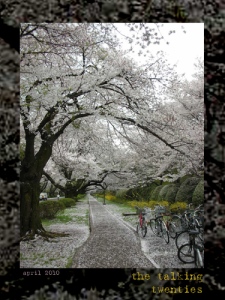Thank you
The Talking Twenties would like to thank all our readers, contributors and everyone else who participated in our blogzine experiment. Though we are now officially closed, we appreciate all of the page views we’ve received over time, and the hard work by our article-writers.
Best of luck to our contributors and readers alike!
Welcome to the Summer 2010 issue
Mother’s Day and culture shifts
Written by Julienne
We celebrate it at the same time every year. It is the quasi-holiday where we honor those who gave us life, and those who teach us to live it. Each May, we reluctantly stand amidst the masses, in the lobby of any number of local restaurants, waiting for a table. What is this day, the veritable bane of my existence? Mother’s Day.
 Don’t get me wrong — I love my mother. She’s funny; she’s caring; she’s accomplished. She, along with my grandmother and aunts, deserve to be recognized for the positive impact they have on my life. But they’re not the reason that May seems to come sooner each year. It’s the florists.
Don’t get me wrong — I love my mother. She’s funny; she’s caring; she’s accomplished. She, along with my grandmother and aunts, deserve to be recognized for the positive impact they have on my life. But they’re not the reason that May seems to come sooner each year. It’s the florists.
No offense, but I’ve never met a florist I haven’t hated. It’s just that, on Mother’s Day, it is inevitable that I find myself in some precarious situation — surrounded by posies, petunias, and pruning shears.
I’m not a bad person. I manage to purchase gifts for birthdays, Christmases, and any number of generic holidays. Father’s Day 2009? Check. (Kayaking lessons.) Wedding shower for my only sibling? Check. (I made all 80 favors by hand.) It’s just this interaction with florists — the porters of the plant life, the bosses of the blossoms — that I don’t have down yet. Read more…
Announcement: TT is going quarterly
After a brief hiatus, we’ve decided to change our content format to quarterly issues (namely Spring, Summer, Fall and Winter). We loved our theme-issue and wish we had the capacity to do more, but in our current incarnation we feel the best way to emphasize the content we have is to take a more relaxed approach.
So what does this mean? You’ll still be seeing our blog-based style of publication, in which articles are published as they are prepared, rather than one large release at the beginning of the month. And you’ll be seeing 4 Letters from the Editor and blogzine “covers” a year. Less pomp, more circumstantial posts!
We hope to see you back here as we continue to develop and find smarter ways of showcasing our material. And don’t forget, your submissions are always welcome!
APRIL
|
The need for green “Toxic air pollutants, or air toxics, are those pollutants known or suspected of causing cancer or other serious health problems, such as birth defects,” reads the EPA site. Through the EPA’s zip code search and mortality comparisons, I was able to learn that the area around my Northeastern hometown has an infant mortality rate significantly higher than the national average, and that the risk of getting cancer from air pollution there is about 40 in a million.” |
This month is the 40th anniversary of Earth Day, a day set aside to examine the long-term environmental sustainability of our current practices and lifestyles and consider the problems pollution is already posing to us. Earth Day is about more than recycling—it’s also about being informed, and thanks to internet, there are much more than at-home green solutions and recycling tips available to anyone wishing to show their concern for the environment.
According to the Earth Day website (www.earthday.net), over a billion people across the world participate in Earth Day campaigns each year. The Earth Day Network (EDN), which began with the first Earth Day in 1970, has been empowered by the internet, contributing to outreach in 174 countries, the creation of an EDN blog and multiple related networks. The online organization network and registry, for example, helps individuals find green events near them or to organize one of their own, while their Educators’ Network gives teachers resources and standard lessons to teach students about environmental preservation and how to green up their classrooms.
Despite increasing awareness of environmental problems over the past several years, however, pollutants such as benzene and carbon tetrachloride—both of which can cause organ damage and death in too high amounts—remain all too prevalent in the air around many communities. The United States Environmental Protection Agency (EPA) offers an online zip code search feature that shows Read more…




